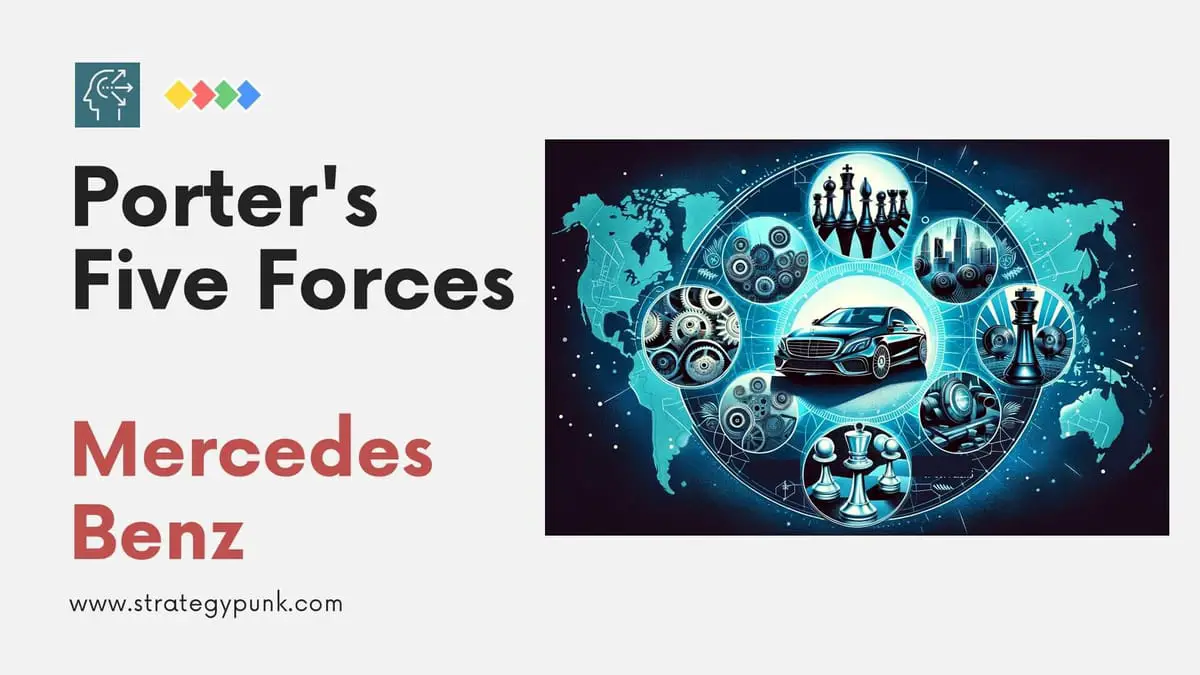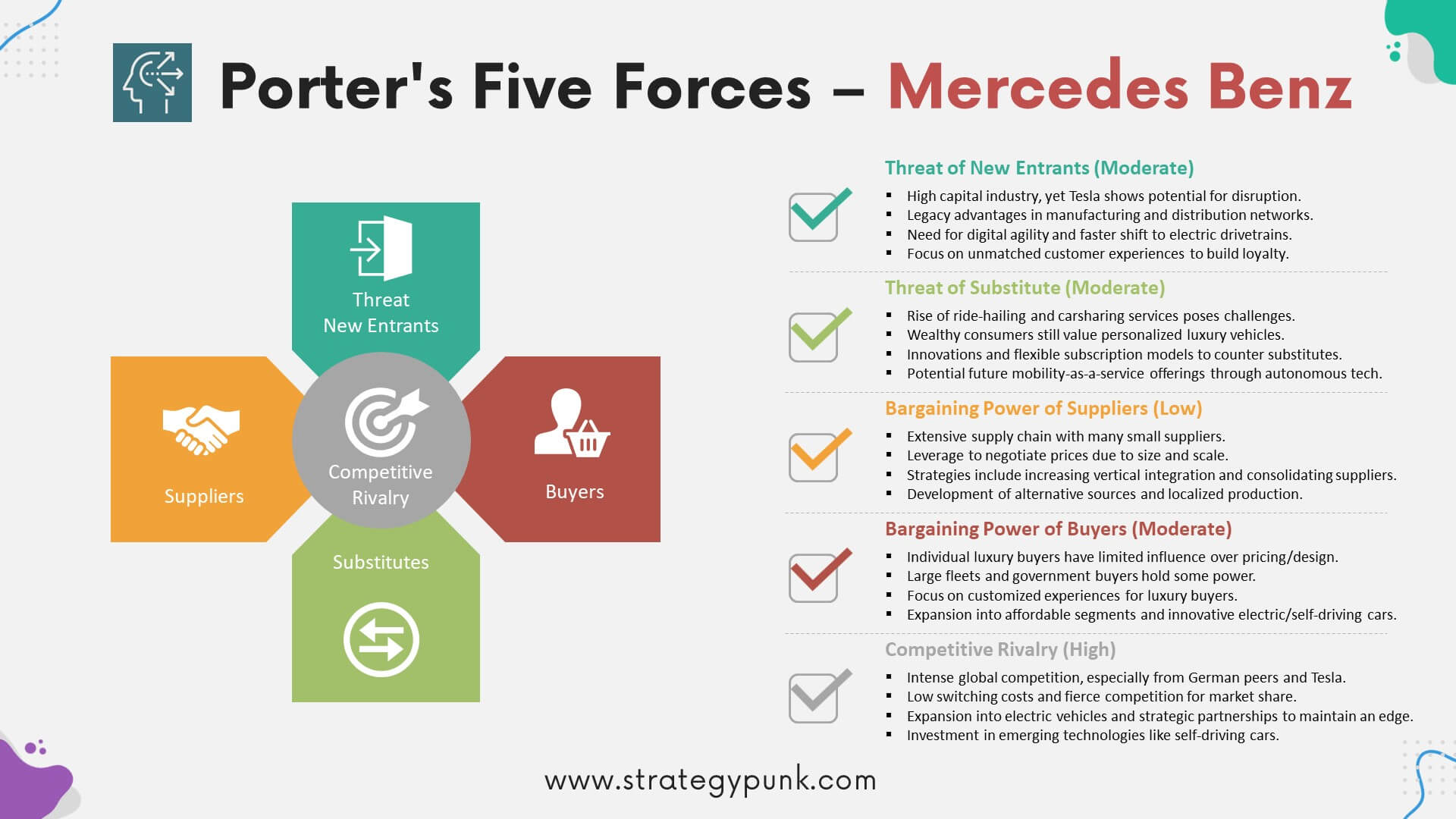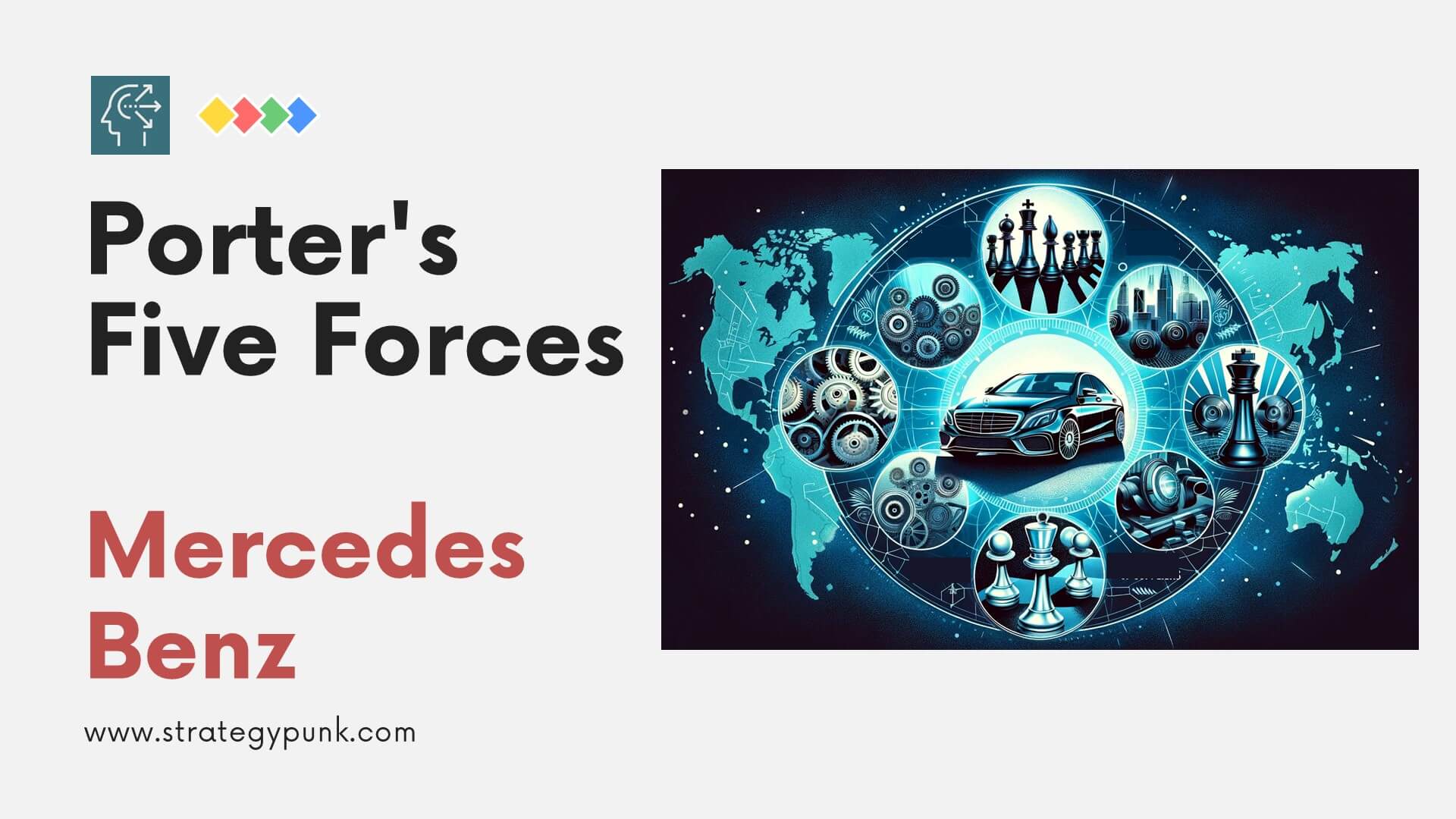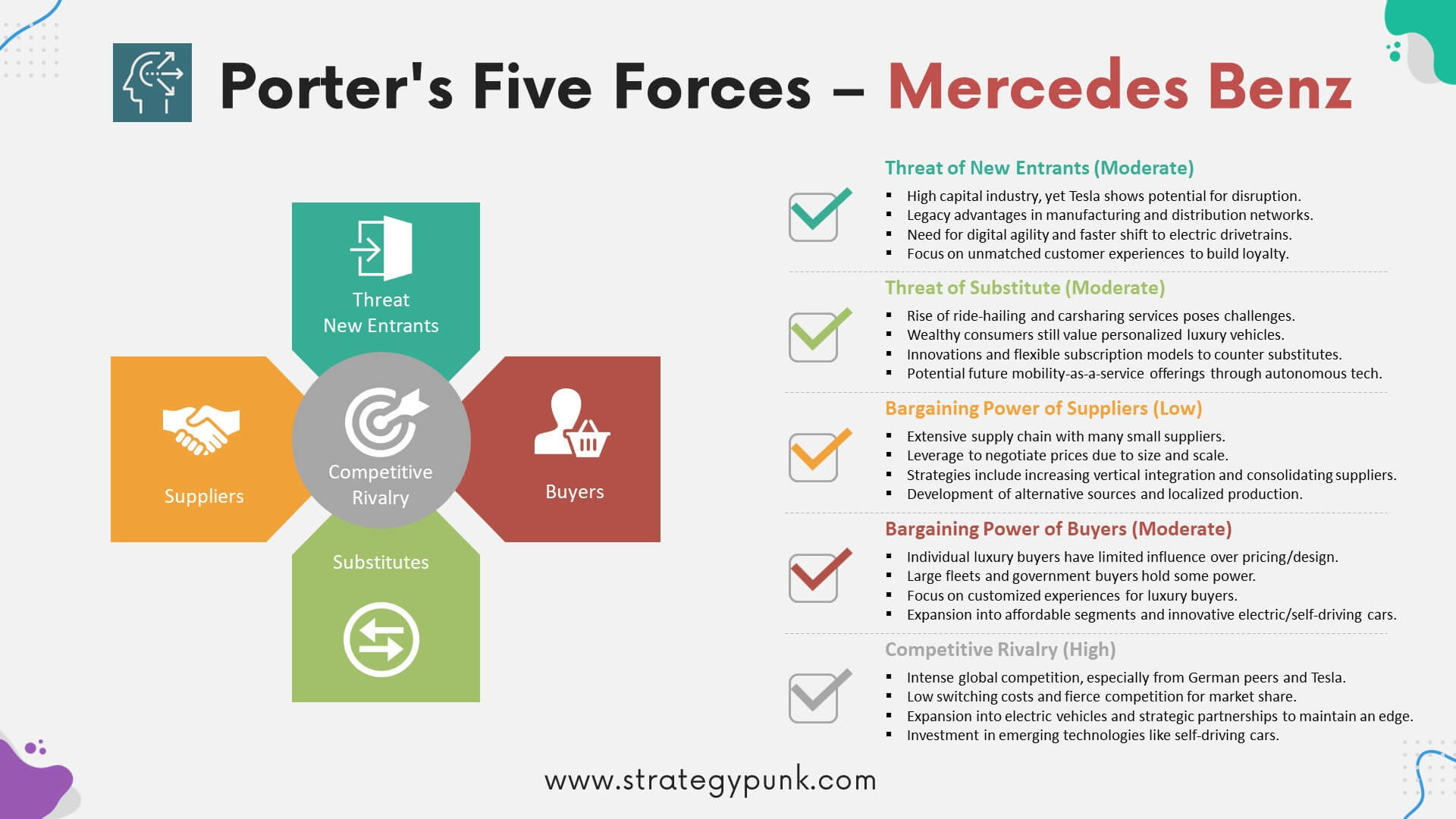Porter's 5 Forces Analysis for Mercedes Benz: Free PPT Template 2025
Explore our in-depth 2025 analysis of Mercedes-Benz using Porter's 5 Forces. Gain strategic insights with our free PowerPoint template on luxury auto trends, competitive dynamics, and market strategies

Introduction: The Luxury Automotive Powerhouse Faces New Challenges
Mercedes-Benz has long been an iconic brand in the automotive industry, synonymous with luxury, innovation, and cutting-edge technology.
The German automaker faces an inflection point amid a confluence of trends reshaping the luxury car market: electrification, self-driving technology, shifting consumer preferences, and new competitors.
We will employ Michael Porter's acclaimed Five Forces framework to analyze Mercedes-Benz's competitive landscape and strategic dynamics.
This strategy tool provides actionable insights to assess the marketplace, understand inherent risks and opportunities, and formulate plans to strengthen competitive advantage.
In this blog post, we will methodically break down each of Porter's Five Forces to reveal the core factors impacting Mercedes-Benz in 2025 and beyond:
- Competitive rivalry
- Threat of new entrants
- Bargaining power of suppliers
- Bargaining power of buyers
- Threat of substitute products
Armed with these insights, we will explore potential strategies for Mercedes-Benz to sustain its leadership in the global luxury car market amidst gathering storms.
So buckle up as we delve into the key insights from our exclusive Porter’s Five Forces analysis for Mercedes Benz.
Download the free PDF and PowerPoint Template below.
Mercedes Benz's Five Forces: Porter's 5 Forces Analysis for Mercedes Benz

Competitive Rivalry: High
The global luxury vehicle industry is intensely competitive, with automakers investing heavily to attract high-end customers. Mercedes Benz faces rivalry from established German peers like BMW and Audi and newcomers like Tesla. With reasonably low switching costs and similar products, competition for market share is fierce.
To differentiate itself, Mercedes is expanding its electric vehicle portfolio and leveraging its heritage in performance and design. Strategic partnerships, like the one with Geely in China, also help Mercedes compete in key growth markets. Further investments in emerging technologies like self-driving and connected vehicles are critical for staying ahead.
The rivalry among current competitors is high.
Threat of New Entrants: Moderate
While the automotive industry has high capital requirements, Tesla's success shows that new entrants can disrupt the luxury segment. However, legacy carmakers still benefit from scale advantages in manufacturing, established distribution networks, and accumulated expertise.
Mercedes Benz should continue to improve its agility and digital capabilities to counter tech-savvy attackers. Accelerating the shift to electric drivetrains is also essential as barriers to entry erode. Additionally, providing unmatched customer experiences can help cement loyalty to the brand.
The threat posed by new entrants is moderate overall.
Threat of Substitutes: Moderate
The growth of ride-hailing services like Uber threatens to replace some private car ownership, especially in urban markets. Carsharing services may also curb sales growth. However, the desire for status and personalized luxury vehicles remains vital for most wealthy consumers.
Mercedes should innovate to mitigate substitution risks and make its vehicles more attractive. Launching flexible subscription packages can also help counter the sharing economy. Investing in autonomous driving technology may allow Mercedes to offer its mobility-as-a-service in the future.
The threat coming from substitutes to Mercedes-Benz's products is moderate.
Bargaining Power of Suppliers: Low
Mercedes Benz's complex supply chain comprises thousands of firms providing specialized components and raw materials. While some high-tech inputs rely on single or limited sources, most suppliers are small companies compared to automakers. This dynamic gives Mercedes significant leverage to negotiate prices and terms.
To improve supply chain efficiency further, Mercedes can increase vertical integration for critical parts like batteries. The company can also continue consolidating its supplier base to deal with fewer, more significant vendors. Developing alternative sources and localizing production are other ways to boost negotiating leverage.
The bargaining power held by Mercedes Benz's suppliers is low overall.
Bargaining Power of Buyers: Moderate
The individual luxury vehicle customer has little influence over pricing or vehicle design. However, large fleets and government buyers command some bargaining power based on purchase volumes. Wealthy consumers also have elevated standards for personalization and service.
Mercedes can provide customized high-touch experiences to attract and retain discerning luxury buyers. The brand may also launch more affordable vehicles to target less affluent segments. Expanding its portfolio of electric and self-driving cars will help attract forward-looking fleet customers. Overall, delivering superior quality and innovation is paramount to limiting buyer power.
On balance, the bargaining power of Mercedes Benz's automotive buyers is moderate.
Final Thoughts
The luxury car industry will grow more competitive as new technologies and business models are reshaped.
Based on Porter's five forces analysis, Mercedes Benz faces high rivalry, moderate threats from new players and substitutes, low supplier power, and moderate buyer power.
Mercedes must double down on product innovation, customer experience, and manufacturing efficiency to sustain its leadership. Capitalizing on electric and autonomous vehicles should be a top priority. Strategic partnerships and targeted mergers and acquisitions can solidify Mercedes' competitive positioning.
Frequently Asked Questions
What are Porter's five forces in the car industry?
Critical aspects of Porter's five forces in the car industry:
- Competitive rivalry is extreme in the car industry due to major global players competing intensely for market share. Brand reputation and product differentiation are key.
- The threat of new entrants could be more substantial due to high capital requirements, established brand loyalty, and economies of scale that incumbents enjoy. However, some tech companies have been able to disrupt.
- Suppliers' bargaining power could be more substantial, as most are small and many alternatives exist. Carmakers can easily switch between suppliers.
- Buyers' bargaining power is moderate. Individual buyers have little leverage, but large fleet purchases confer some pricing power.
- Threat of substitutes is moderate. Public transport poses some threat, but the convenience of cars limits complete substitution. Emerging ride-sharing also poses a long-term threat.
The car industry is highly competitive, with the most vigorous rivalry among existing players. Brand equity and cost positions are significant competitive advantages. New technologies and business models also present opportunities and threats.
What are the five forces of Porter's case analysis?
Key aspects of Porter's five forces analysis:
- Competitive Rivalry - The intensity of competition among existing firms in an industry. A high degree of rivalry limits profit potential.
- Bargaining Power of Suppliers - The influence suppliers have over firms in an industry in terms of driving up prices or reducing quality. Powerful suppliers reduce profit potential.
- Bargaining Power of Buyers - Customers' influence over firms in an industry in terms of driving down prices or demanding better quality. Influential buyers reduce profit potential.
- Threat of New Entrants - The ease with which new competitors can enter an industry impacts profitability. Easy entry reduces profit potential.
- Threat of Substitutes - The availability of alternative products that meet the same customer needs impacts industry profitability. Easy substitution reduces profit potential.
Porter's five forces analysis examines the structural factors determining an industry's competitiveness and profitability. It provides insights into opportunities and threats facing companies so they can formulate effective strategies. The goal is to minimize the power of competitive forces and optimize a firm's position.
Porter's 5 Forces Analysis for Mercedes Benz PowerPoint Template
free and fully editable PPT template
Equipped with a detailed understanding of industry forces, executives can make informed strategic choices. Please download this free PowerPoint template to visualize Porter's analysis for Mercedes-Benz.


Mercedes Benz Porter's 5 Forces Analysis PowerPoint Template





